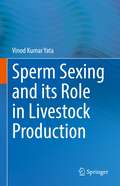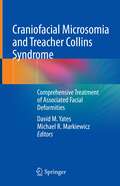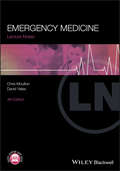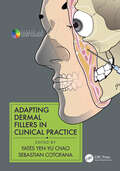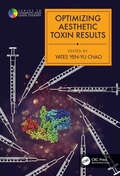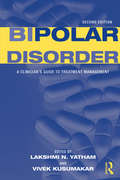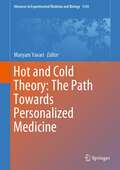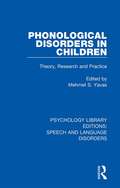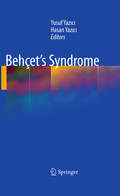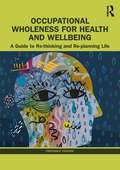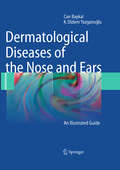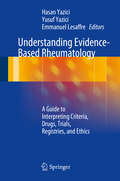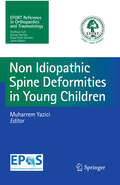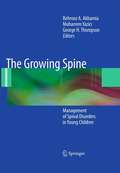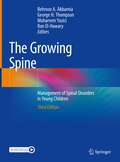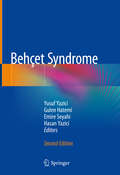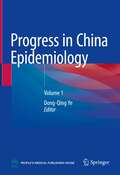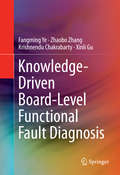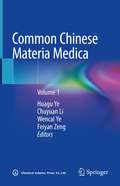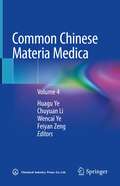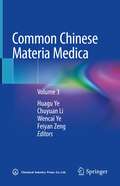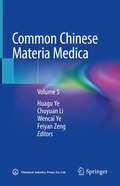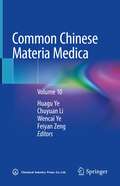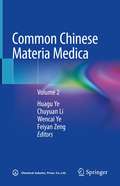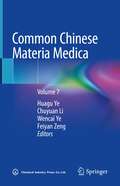- Table View
- List View
Sperm Sexing and its Role in Livestock Production
by Vinod Kumar YataThis book presents basic principles and discusses the state-of-the-art methods of sperm sexing in livestock. It reviews the challenges and critical opinions on the conventional sperm sexing methods and characteristic features of spermatozoa of farm animals which could help to develop novel methods of sperm sexing. The book also presents principles and applications of flow cytometry for sperm separation. The chapters of the book elucidate methods and difficulties in developing sperm sexing methods. Notably, it covers recent research on immunological and nanotechnology-based sperm sexing methods. The book also provides information on the development of semen extenders. Towards the end, the book examines ethical and commercial aspects of sperm sexing. It is an ideal reference book for students, researchers and professionals working towards improving livestock production.
Craniofacial Microsomia and Treacher Collins Syndrome: Comprehensive Treatment of Associated Facial Deformities
by David M. Yates Michael R. MarkiewiczThe book provides a framework for diagnosis and treatment of the complex facial deformities found in craniofacial microsomia and Treacher Collins syndrome. These conditions are difficult to treat due to their complexity and variable presentation. The deformities may be mild or severe and merely cosmetic to life-threatening in nature. These conditions often manifest as complex facial deformities that require multiple surgical interventions. Timing is critical when treating these patients and knowing and choosing the correct operation is key to successful outcomes. This work provides a comprehensive approach in treating these complex patient populations, seeking to answer the following questions: When to operate versus when to wait? If operating is required what operation should be performed? What is the best orthodontic approach to the associated dental deformities that develop with these conditions? How should sleep apnea be evaluated and treated in this population? What is the best management for feeding patients with these conditions? Written by experts in the field, Craniofacial Microsomia and Treacher Collins Syndrome: Comprehensive Treatment of Associated Facial Deformities aims to provide the reader with literature based best practices in treating these children from the NICU through childhood and into adulthood.
Lecture Notes: Emergency Medicine
by David Yates Chris MoultonEmergency Medicine Lecture Notes provides all the necessary information, within one short volume, for a sound introduction to this core specialty area.Presented in a user-friendly format, combining readability with flowcharts and high-quality illustrations, this fourth edition has been thoroughly revised to reflect recent advances in the field of emergency medicine. For this new edition, Emergency Medicine Lecture Notes features:* Illustrations and flow charts in a two colour presentation throughout* More detail on imaging, diagnosis and management of a wide range of acute conditions* A brand new companion website at www.lecturenoteseries.com/emergencymed featuring a selection of MCQs to test readers on common pitfalls in emergency medicineNot only is this book a great starting point to support initial teaching on the topic, but it is easy to dip in and out of for reference or revision at the end of a module, rotation or final exams. Whether you need to develop or refresh your knowledge of emergency medicine, Emergency Medicine Lecture Notes presents 'need to know' information for all those involved in treating those in an emergency setting.
Adapting Dermal Fillers in Clinical Practice (Series in Cosmetic and Laser Therapy)
by Yates Yen-Yu ChaoThere have been many different brands of dermal fillers approved for use for soft tissue augmentation in the US market alone, comprising four different types of temporary fillers and one permanent type, with several other brands and types also available elsewhere in the world. Against such a potentially bewildering variety and range of choices, this new text offers a scientific and an anatomic rationale for why a particular filler should be selected as optimal for each individual location and indication and how it should best be used in treatments. International experts share their clinical knowledge and expertise to guide all levels of esthetic practitioners toward the best results for each individual patient. CONTENTS: Fundamentals of Injectable Filler Procedures * Basic Injection Techniques * Modified and Advanced Injection Techniques * Novel Injection Techniques * Esthetic Filler Injection Pearls * Adapting Injection Techniques to Different Regions * Adapting Injection Techniques to Special Indications * Adapting Injection Techniques to Different Filling Materials * Adapting Injection Techniques to Different Genders * Adapting Injection Techniques to Different Age Groups * Adapting Injection Techniques to Patients of Different Ethnicity * Prevention and Management of Complications.
Optimizing Aesthetic Toxin Results (Series in Cosmetic and Laser Therapy)
by Yates Yen-Yu ChaoBotulinum toxin injections are the most used and best-known aesthetic treatment internationally, but there remain a number of problematic topics and suboptimal results. Here an internationally known expert and his contributors explain the scientific background and aesthetic principles that can help clinicians achieve better results in problem cases.
Bipolar Disorder: A Clinician's Guide to Treatment Management (Oxford Psychiatry Library)
by Lakshmi N. Yatham Vivek KusumakarFirst published in 2009. Routledge is an imprint of Taylor & Francis, an informa company.
Hot and Cold Theory: The Path Towards Personalized Medicine (Advances in Experimental Medicine and Biology #1343)
by Maryam YavariThis book is about the theory of Hot and Cold, a mutual fundamental base of traditional medicines all around the world. The theory describes the dynamic balance state of the body on the axis of hot and cold for each individual and proposes the fact that deviation from this equilibrium is a predisposing factor for diseases. Such an approach helps practitioners to provide treatments tailored to the patient’s condition, not the disease. This book, for the first time, has gathered native descriptions of Hot and Cold theory in different traditional medicines, including traditional Chinese medicine, Persian (Humoral, Unani) medicine, Ayurvedic medicine and Latin American and Caribbean medicines. After defining the common ground, contemporary research - in nutrition, pharmacology, physiology and systems biology - has been explored using scientific methodology. This work is the result of an international collaboration of more than 30 scientists and scholars with high reputations in their fields. Hot and Cold theory, as a holistic individualized approach in prevention, diagnosis and treatment, can be merged into the novel fast-paced concepts in systems biology and precision medicine. Through this bridge, the authors propose that the Hot and Cold theory should be revisited more deeply by medical scientists, who are the main audience of this book, to pave the way towards integrated holistic personalized medicine.
Phonological Disorders in Children: Theory, Research and Practice (Psychology Library Editions: Speech and Language Disorders)
by Mehmet S. YavasOriginally published in 1991, the recent developments in the study of phonological disorders in children had led to a fruitful interaction between speech pathology and phonology. It is one aspect of the application of linguistic theory to the study of speech and language disorders which had opened up a new field, clinical linguistics. This book brings together the concerns of the linguist and the speech pathologist; the essays chosen share the quality of not discussing theory or therapy without addressing the implications one has for the other. By concentrating on recent work the editor hoped to stimulate further discussion in this important and fast growing area of research.
Behçet’s Syndrome
by Yusuf Yazıcı Hasan YazıcıBehçet's Syndrome has seen great strides over the last two decades in the availability of new treatments and the understanding of underlying pathogenesis. Only 30 years ago the majority of particularly young men with Behçet's lost total eye sight, now only a minority do. This book covers the most recent developments in the basic and clinical aspects of Behçet's Syndrome. International authorities have collaborated to offer their diverse expert knowledge on the multiple affected organs and systems, including the skin, the eye, the brain, the lungs and not the least the gastrointestinal and the locomotor systems. A special chapter is devoted to juvenile disease. The definitive resource on Behçet's Syndrome, this book is well suited for rheumatologists, dermatologists, ophthalmologists, neurologists, and health professionals caring for Behçet's patients.
Occupational Wholeness for Health and Wellbeing: A Guide to Re-thinking and Re-planning Life
by Farzaneh YazdaniThis practical book introduces a new, research-based model of occupational wholeness, a way of conceptualising satisfaction with what one does to meet needs for being, belonging and becoming. It explores how to: conceptualise people's life stories through the model; take vital steps to help identify any problems; draw personal profiles; introduce intervention strategies for promoting wellbeing. Focusing on enhancing wellbeing, rather than ill health, the concept of occupational wholeness supports people to feel more control of their own lives and helps to identify what balance can be created, while recognising personal limitations and environmental restrictions. Alongside theoretical background, it includes practice applications and practical tools, with scenarios and activities to consolidate learning. Providing a unique combination of the practice and theory of occupational science, Yazdani integrates occupational science, psychology and sociology with clinical experience of working with diverse groups of people in different countries. This book is an important guide and reference for occupational therapists, occupational scientists, counsellors and life coaches.
Dermatological Diseases of the Nose and Ears
by K. Didem Yazganoglu Can Baykal"Dermatological Diseases of the Nose and Ears" gives comprehensive information about the lesions of these regions. It contains high quality original clinical pictures, which make the diagnosis easier in this important aspect of clinical dermatological practice. All diseases involving the nose and ears are discussed separately with a clinical differential diagnostic approach. As a result approximately 600 different diseases are addressed in the book. In clinical practice, physicians may observe lesions of the nose or ear only. After identifying the elementary lesion, the clinician can more easily uncover the diagnosis of a local or disseminated or systemic disease with the help of this book. Furthermore, this color illustrated book guides the reader to the diagnosis of the prevalent skin tumors frequently involving these localizations, addressing an important health care problem.
Understanding Evidence-Based Rheumatology
by Hasan Yazici Yusuf Yazici Emmanuel LesaffreIt is imperative that health professionals caring for patients with rheumatic diseases understand how to correctly interpret evidence in their field, taking into account the merits and shortcomings of available data. Understanding Evidence-Based Rheumatology offers a practical assessment of criteria, drugs, trials, and registries and provides useful tools for successfully interpreting this data. The book introduces readers to basic analysis of trial design, statistics and application of data through no-nonsense, easy-to-follow insights. Using numerous examples, chapters outline the difficulties physicians encounter when measuring disease activity in rheumatology and offer strategies for systematically approaching these situations. Ethical issues in study design and reporting are examined and the book closes with a summary of future directions for scientific and clinical studies in rheumatology. Understanding Evidence-Based Rheumatology is an invaluable resource for trainees, clinicians and scientists, preparing them with the necessary tools to correctly gather evidence and shed light on the difficult practice of rheumatology.
Non-Idiopathic Spine Deformities in Young Children
by Muharrem YaziciNon-idiopathic early onset scoliosis represents a true challenge to the physician due to the significance of the ongoing growth of the spine, the risk of curve progression, and the risk of pulmonary insufficiency. A comprehensive review of the growth mechanisms of spine in infancy forms the basis of the book. Clinical evaluation and imaging of early onset scoliosis contribute to the diagnostic overview. The main causes of non-idiopathic early onset scoliosis are briefly described in the second part of the book. The last group of chapters presents the conservative and surgical treatments that are available along with their results, chances and challenges. This comprehensive guide is an opportunity for every specialist involved in the treatment of these severe deformities, to obtain an update of the actual trends and knowledge in the field in a one-point reference.
The Growing Spine
by Muharrem Yazici George H. Thompson Behrooz A. AkbarniaSpinal disorders in very young children may be caused by a variety of conditions. The treatment of such conditions is often challenging due to the age of the patient and the progressive nature of the deformity. There also may be associated problems such as congenital anomalies, respiratory insufficiency, and neurological problems. Depending on the etiology of the deformity, these children are often cared for by multiple specialists including pediatricians, pediatric orthopaedists or orthopaedic spine surgeons, neurologists, pediatric surgeons, pediatric neurosurgeons, oncologists, and/or pulmonologists. Health professionals in all of the mentioned disciplines are involved in the management of these patients, which is why compiling a comprehensive textbook that is not limited to orthopedic specialists is essential. This textbook will effectively help to standardize the care of these patients. Furthermore, other professionals such as nurses, physical therapists and healthcare professionals in training are usually not familiar with these conditions and are in need of a reference book to consult when caring for children with spinal deformities.
The Growing Spine: Management of Spinal Disorders in Young Children
by Muharrem Yazici George H. Thompson Behrooz A. Akbarnia Ron El-HawaryThere has been significant progress in the field of spinal disorders in very young children over the past two decades. However, the treatment of such conditions remains challenging due to the age of the patient, different etiologies, associated morbidities and the progressive nature of the deformity. Depending on the etiology of the deformity, these children are often cared for by multiple specialists including pediatricians, pulmonologists, pediatric orthopedists or orthopedic spine surgeons, pediatric surgeons, pediatric neurosurgeons, neurologists and oncologists. Health professionals in all of the mentioned disciplines are involved in the management of these patients, which is why compiling a comprehensive text that is not limited to orthopedic specialists is essential. Since the second edition of this book was published, there has been a significant body of literature that has been published and advances made in the care of young children with spinal and thoracic deformities. This new edition will effectively help to standardize the care of these patients. Furthermore, other professionals, such as nurses, physical therapists and healthcare professionals in training, are usually not familiar with these conditions and are in need of a reference book to consult when caring for young children with spinal deformities. Sections are arranged thematically and comprise a comprehensive presentation of the current knowledge on disorders of the growing spine. After opening sections discussing general considerations and patient evaluation and diagnosis, subsequent sections describe the various categories of spinal deformity - idiopathic, congenital, neuromuscular, syndromic, and others - followed by surgical and non-surgical management strategies, both traditional and growth-friendly. Concluding sections address patient care and outcomes and outline future directions for research and practice.
Behçet Syndrome
by Yusuf Yazici Gulen Hatemi Emire Seyahi Hasan YaziciThe expanded second edition of this important work provides an up-to-date and comprehensive overview of Behçet syndrome. New and updated chapters focus on recent advances in the areas of pathogenesis, the microbiome, genetics and epigenetics, clustering of symptoms, disease assessment and new treatment options. The book examines how these developments have changed the way physicians approach diagnosis, treatment, and management of Behçet patients. It also analyzes the wide variety of clinical manifestations of the disease including mucocutaneous lesions, intraocular inflammation, central nervous system involvement, deep vein thrombosis and other forms of major vascular disease. Building on the success of its predecessor, the Second Edition of Behçet Syndrome is an invaluable resource for physicians, residents, fellows, and graduate students in rheumatology, dermatology, ophthalmology, neurology, gastroenterology, and internal medicine.
Progress in China Epidemiology: Volume 1
by Dong-Qing YeThis book is intended to show the great achievements and valuable experience of Chinese public health practices and epidemiological theories and methods. It is conducive to expanding medical workers’ practical ability of disease prevention and control, and to bridging the gap between clinical medicine and public health.In part 1, it introduces the progress in epidemiology of 10 infectious diseases. In part 2, it covers 11 non-communicable diseases. The research method and prediction modelling and public health ethics are discussed in the 11 chapters of part 3. The contributors include epidemiologists and public health experts, as well as more clinicians, mathematicians, sociologists, philosophers (ethicists), bioinformatics and so on. Among them, there are not only professors from universities, but also researchers from scientific research institutes, and experts in the front line of disease prevention and control.
Knowledge-Driven Board-Level Functional Fault Diagnosis
by Fangming Ye Zhaobo Zhang Krishnendu Chakrabarty Xinli GuThis book provides a comprehensive set of characterization, prediction, optimization, evaluation, and evolution techniques for a diagnosis system for fault isolation in large electronic systems. Readers with a background in electronics design or system engineering can use this book as a reference to derive insightful knowledge from data analysis and use this knowledge as guidance for designing reasoning-based diagnosis systems. Moreover, readers with a background in statistics or data analytics can use this book as a practical case study for adapting data mining and machine learning techniques to electronic system design and diagnosis. This book identifies the key challenges in reasoning-based, board-level diagnosis system design and presents the solutions and corresponding results that have emerged from leading-edge research in this domain. It covers topics ranging from highly accurate fault isolation, adaptive fault isolation, diagnosis-system robustness assessment, to system performance analysis and evaluation, knowledge discovery and knowledge transfer. With its emphasis on the above topics, the book provides an in-depth and broad view of reasoning-based fault diagnosis system design. * Explains and applies optimized techniques from the machine-learning domain to solve the fault diagnosis problem in the realm of electronic system design and manufacturing; * Demonstrates techniques based on industrial data and feedback from an actual manufacturing li≠ * Discusses practical problems, including diagnosis accuracy, diagnosis time cost, evaluation of diagnosis system, handling of missing syndromes in diagnosis, and need for fast diagnosis-system development.
Common Chinese Materia Medica: Volume 1
by Huagu Ye Chuyuan Li Wencai Ye Feiyan ZengThis first volume describes 78 species of medicinal plants in 44 families, in which 7 families and 13 species are algae and fungi, 28 families and 52 species are ferns, 9 families and 13 species are gymnosperms. The algae include Laminaria japonica, Sargassum fusiforme, Ulva lactucam, Uiva pertusa et al.; the fungi include Calvatia lilacina, Calvatia lilacina, Cordyceps sobolifera, et al.; the gymnosperms include Ginkgo biloba, Pinus massoniana, Thuja orientalis, Ephedra sinica, Ephedra intermedia, Ephedra equisetina, et al. In each specie, it introduces the scientific names, herbal medicine names, characteristics, habitats, distributions, Acquisition and processing methods, medicinal traits, tastes, functions, use and dosages, and other information of medicinal plants. The color pictures of all species in their wild forms are presented, along with some pictures of medicinal products made of them. This book series has totally 10 volumes, which covers 2000 kinds of Chinese medicines that are commonly seen or used. These volumes not only introduce the efficacy function and some prescriptions of the medicines, but also introduce the biological characteristics of them in detail with clear photos of the habitats, so that readers can identify them in the field. Apart from the growing environment, the books expound the distribution areas and other information to facilitate researches and other applications. The volumes are targeted at readers of general interests and it is also of high referential value for scientific researcher and teachers. It can be used as a guide to researchers, clinical doctors, and students in the department of pharmaceutics and traditional Chinese medicine.
Common Chinese Materia Medica: Volume 4
by Huagu Ye Chuyuan Li Wencai Ye Feiyan ZengThis fourth volume describes 256 species of medicinal plants from 5 families, which are commonly used in Chinese medicine. The most important species are Agrimonia pilosa, Amygdalus persica, Armeniaca mume, Armeniaca vulgaris, Armeniaca sibirica, Chaenomeles sinensis, Eriobotrya japonica of Rosaceae; Chimonanthus praecox of Calycanthaceae;Albizia julibrissin, Archidendron clypearia, Entada phaseoloides, Bauhinia championii of Mimosoideae; Caesalpinia sappan, Cassia tora, Gleditsia sinensis of Caesalpiniaceae; Abrus cantoniensis, Astragalus membranaceus, Astragalus membranaceus, Dalbergia odorifera, Desmodium caudatum, Desmodium styracifolium, Erythrina variegata, Euchresta japonica, Flemingia prostrata, Glycyrrhiza uralensis, Glycyrrhiza inflata, Glycyrrhiza glabra, Lablab purpureus, Sophora japonica and Spatholobus suberectus of Butterflyaceae. In each specie, it introduces the scientific names, medicinal names, morphologies, habitats, distributions, acquisition and processing methods of these medicinal plants, the content of medicinal properties, therapeutic effects, usage and dosage of these medicinal plants, and attaches unedited color pictures and pictures of part herbal medicines of each species. This book series has 10 volumes in total, which covers over 2000 kinds of Chinese medicines that are commonly used. These volumes not only introduce the efficacy function and some prescriptions of the medicines, but also introduce the biological characteristics of them in detail with clear photos of the habitats, so that readers can identify them in the field. Apart from the growing environment, the books expound the distribution areas and other information to facilitate researches and other applications. The volumes are targeted at readers of general interests and it is also of high referential value for scientific researcher and teachers. It can be used as a guide to researchers, clinical doctors, and students in the department of pharmaceutics and traditional Chinese medicine.
Common Chinese Materia Medica: Volume 3
by Huagu Ye Chuyuan Li Wencai Ye Feiyan ZengThis third volume describes 226 species of 32 families of medicinal plants, which are commonly used in Chinese medicine. The most important species are Aquilaria sinensis and Daphne genkwa of Thymelaeaceae; Benincasa hispida, Siraitia grosvenorii, Trichosanthes kirilowii and Trichosanthes rosthornii of Cucurbitaceae; Camellia sinensis of Theaceae; Cleistocalyx operculatus, Eugenia caryophyllata and Rhodomyrtus tomentosa of Myrtaceae; Osbeckia chinensis of Melastomataceae; Quisqualis indica and Terminalia chebula of Combretaceae; Hypericum japonicum of Hypericaceae; Microcos paniculata of Tiliaceae; Hibiscus mutabilis of Malvaceae; Croton crassifolius, C. lachnocarpus, C. tiglium, Euphorbia humifusa, E. lathyris, E. pekinensis, Phyllanthus emblica and Sauropus spatulifolius of Euphorbiaceae. In each specie, it introduces the scientific names, medicinal names, morphologies, habitats, distributions, acquisition and processing methods of these medicinal plants, the content of medicinal properties, therapeutic effects, usage and dosage of these medicinal plants, and attaches unedited color pictures and pictures of part herbal medicines of each species.This book series has 10 volumes in total, which covers over 2000 kinds of Chinese medicines that are commonly used. These volumes not only introduce the efficacy function and some prescriptions of the medicines, but also introduce the biological characteristics of them in detail with clear photos of the habitats, so that readers can identify them in the field. Apart from the growing environment, the books expound the distribution areas and other information to facilitate researches and other applications. The volumes are targeted at readers of general interests and it is also of high referential value for scientific researcher and teachers. It can be used as a guide to researchers, clinical doctors, and students in the department of pharmaceutics and traditional Chinese medicine.
Common Chinese Materia Medica: Volume 5
by Huagu Ye Chuyuan Li Wencai Ye Feiyan ZengThis fifth volume contains 253 species of medicinal plants from 25 families, which are commonly used in Chinese medicine. The most important species are Stachyurus himalaicus of Stachyuraceae; Liquidambar formosana, Semiliquidambar cathayensis of Hamamelidaceae; Broussonetia papyrifera, Cudrania cochinchinensis, Cudrania tricuspidata, Ficus carica, Morus alba of Moraceae; Boehmeria nivea and Pouzolzia zeylanica of Urticaceae; Cannabis sativa of Cannabaceae; Ilex asprella, Ilex cornuta, Ilex latifolia, Ilex pubescens of Aquifoliaceae; Euonymus alatus, Tripterygium wilfordii of Celastraceae; Taxillus chinensis, Viscum liquidambaricola of Loranthaceae; Santalum album of Santalaceae; Berchemia lineata, Ventilago leiocarpa, Ziziphus jujuba, Ziziphus jujuba var. Spinosa, Elaeagnus pungens of Rhamnaceae; Citrus aurantium, Citrus grandis var. tomentosa, Citrus medica var. sarcodactylis, Citrus reticulata, Evodia rutaecarpa, Phellodendron chinense and Zanthoxylum bungeanum of Rutaceae. In each specie, it introduces the scientific names, medicinal names, morphologies, habitats, distributions, acquisition and processing methods of these medicinal plants, the content of medicinal properties, therapeutic effects, usage and dosage of these medicinal plants, and attaches unedited color pictures and pictures of part herbal medicines of each species. This book series has 10 volumes in total, which covers over 2000 kinds of Chinese medicines that are commonly used. These volumes not only introduce the efficacy function and some prescriptions of the medicines, but also introduce the biological characteristics of them in detail with clear photos of the habitats, so that readers can identify them in the field. Apart from the growing environment, the books expound the distribution areas and other information to facilitate researches and other applications. The volumes are targeted at readers of general interests and it is also of high referential value for scientific researcher and teachers. It can be used as a guide to researchers, clinical doctors, and students in the department of pharmaceutics and traditional Chinese medicine.
Common Chinese Materia Medica: Volume 10
by Huagu Ye Chuyuan Li Wencai Ye Feiyan ZengThis tenth volume records 5 species of resin, 74 species of animals, 41 species of minerals and fossils. There are resins such as Liquidambar orientalis, Commiphore myrrha, Boswellia carterii, Garcinia hanburyi; animals such as Solenognathus hardwickii, , Cervus nippon, Scolopendra subspinipes, Cryptotympana pustulata, Agkistrodon acutus, Bombyx mori, Collocalia esculenta, Moschus moschiferus, Hippocampus kelloggi, Gekko gekko; minerals and fossils such as mercury, gypsum, alum, mirabilite, cinnabar, actinolite, calomel, keel, dens draconis, lithodes, fossilia spiriferis. In each specie, it introduces the scientific names, medicinal names, morphologies, habitats, distributions, acquisition and processing methods of these medicinal plants, the content of medicinal properties, therapeutic effects, usage and dosage of these medicinal plants, and attaches unedited color pictures and pictures of part herbal medicines of each species. This book series has 10 volumes in total, which covers over 2000 kinds of Chinese medicines that are commonly used. These volumes not only introduce the efficacy function and some prescriptions of the medicines, but also introduce the biological characteristics of them in detail with clear photos of the habitats, so that readers can identify them in the field. Apart from the growing environment, the books expound the distribution areas and other information to facilitate researches and other applications. The volumes are targeted at readers of general interests and it is also of high referential value for scientific researcher and teachers. It can be used as a guide to researchers, clinical doctors, and students in the department of pharmaceutics and traditional Chinese medicine.
Common Chinese Materia Medica: Volume 2
by Huagu Ye Chuyuan Li Wencai Ye Feiyan ZengThis second volume contains 231 species of 40 families of medicinal plants. The most important family of which are Magnoliaceae, such as Magnolia officinalis and Magnolia officinalis subsp. biloba; Schisandra chinensis of Schisandraceae; Cinnamomum aromaticum of Lauraceae, Coptis chinensis Franch., Coptis omeiensis and Coptis teeta of Berberidaceae; Isatis indigotica, Lepidium apetalum and Raphanus sativus of Cruciferae; Rheum palmatum, Rheum officinale and Rheum taguticum of Polygonaceae, etc. In each specie, it introduces the scientific names, herbal medicine names, characteristics, habitats, distributions, Acquisition and processing methods, medicinal traits, tastes, functions, use and dosages, and other information of medicinal plants. The color pictures of all species in their wild forms are presented, along with some pictures of medicinal products made of them. This book series has totally 10 volumes, which covers 2000 kinds of Chinese medicines that are commonly seen or used. These volumes not only introduce the efficacy function and some prescriptions of the medicines, but also introduce the biological characteristics of them in detail with clear photos of the habitats, so that readers can identify them in the field. Apart from the growing environment, the books expound the distribution areas and other information to facilitate researches and other applications. The volumes are targeted at readers of general interests and it is also of high referential value for scientific researcher and teachers. It can be used as a guide to researchers, clinical doctors, and students in the department of pharmaceutics and traditional Chinese medicine.
Common Chinese Materia Medica: Volume 7
by Huagu Ye Chuyuan Li Wencai Ye Feiyan ZengThis seventh volume describes 247 species of 9 families of medicinal plants, which are commonly used in Chinese medicine. The most important species are Adina rubella, Gardenia jasminoides, Hedyotis diffusa, Morinda officinalis, Rubia cordifolia, Uncaria hirsuta, Uncaria macrophylla, Uncaria rhynchophylla, Uncaria sessilifructus, Uncaria sinensis of Rubiaceae; Lonicera confusa, Lonicera hypoglauca, Lonicera macranthoides, Lonicera japonica of Caprifoliaceae; Patrinia scabiosaefolia, Patrinia villosa, Nardostachys jatamansi of Valerianaceae; Dipsacus asperoides of Dipsacaceae; Arctium lappa, Artemisia annua, Artemisia argyi, Artemisia capillaris, Artemisia scoparia, Atractylodes lancea, Atractylodes macrocephala, Dendranthema indicum, Dendranthema morifolium, Eupatorium chinense, Eupatorium fortunei, Inula helenium, Saussurea costus, Saussurea involucrata, Senecio scandens, Serratula chinensis, Siegesbeckia orientalis, Solidago decurrens, Taraxacum mongolicum, Tussilago farfara、Xanthium sibiricum of Compositae; Gentiana crassicaulis, Gentiana manshurica, Gentiana rigescens, Gentiana scabra, Swertia pseudochinensis of Valerianaceae; Lysimachia christinae of Primulaceae and Plantago asiatica of Plantaginaceae. In each specie, it introduces the scientific names, medicinal names, morphologies, habitats, distributions, acquisition and processing methods of these medicinal plants, the content of medicinal properties, therapeutic effects, usage and dosage of these medicinal plants, and attaches unedited color pictures and pictures of part herbal medicines of each species. This book series has 10 volumes in total, which covers over 2000 kinds of Chinese medicines that are commonly used. These volumes not only introduce the efficacy function and some prescriptions of the medicines, but also introduce the biological characteristics of them in detail with clear photos of the habitats, so that readers can identify them in the field. Apart from the growing environment, the books expound the distribution areas and other information to facilitate researches and other applications. The volumes are targeted at readers of general interests and it is also of high referential value for scientific researcher and teachers. It can be used as a guide to researchers, clinical doctors, and students in the department of pharmaceutics and traditional Chinese medicine.
